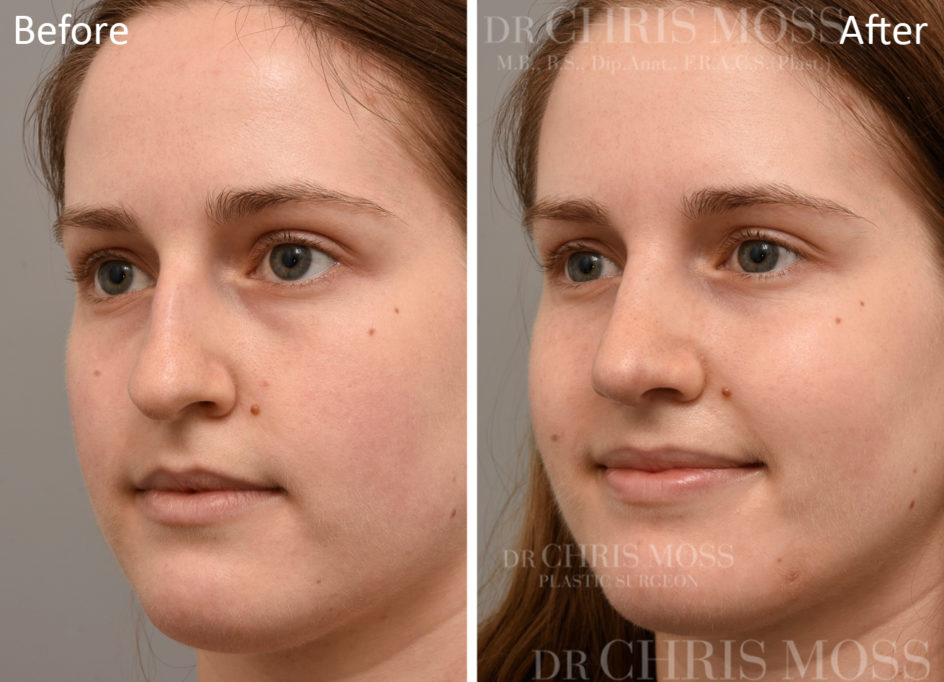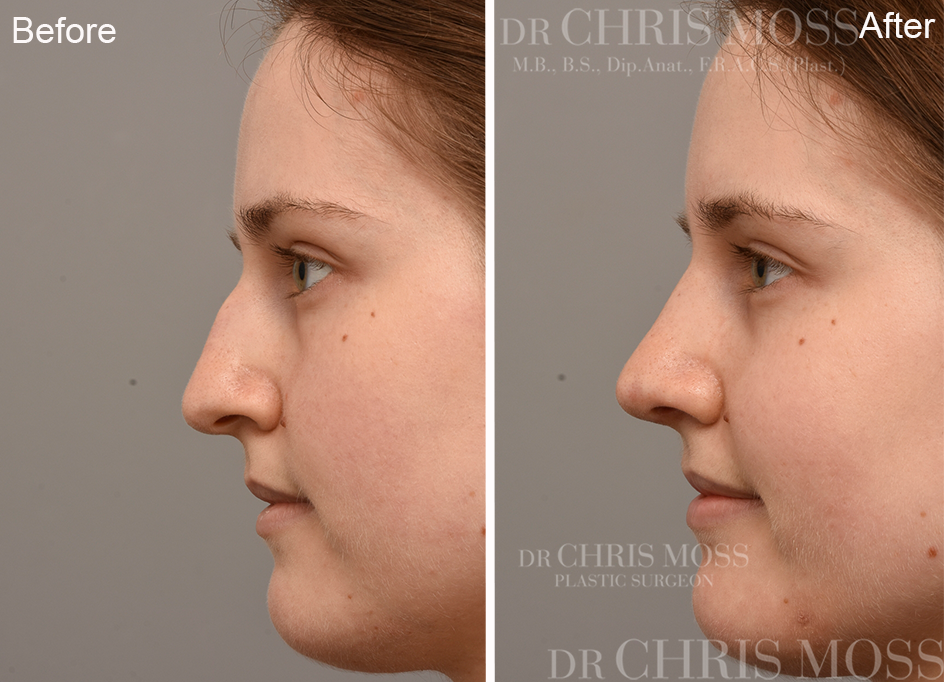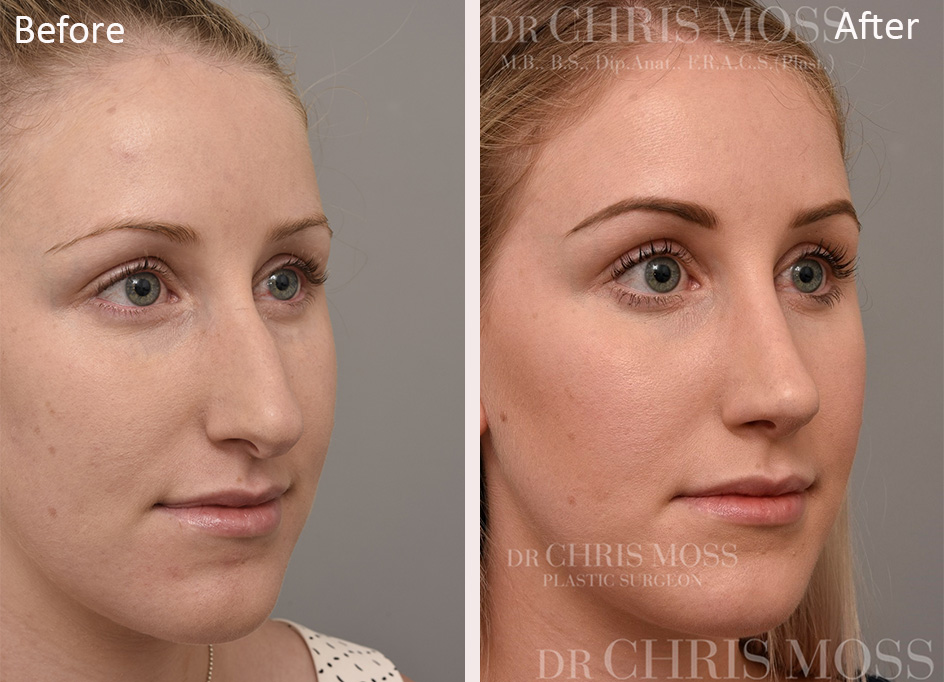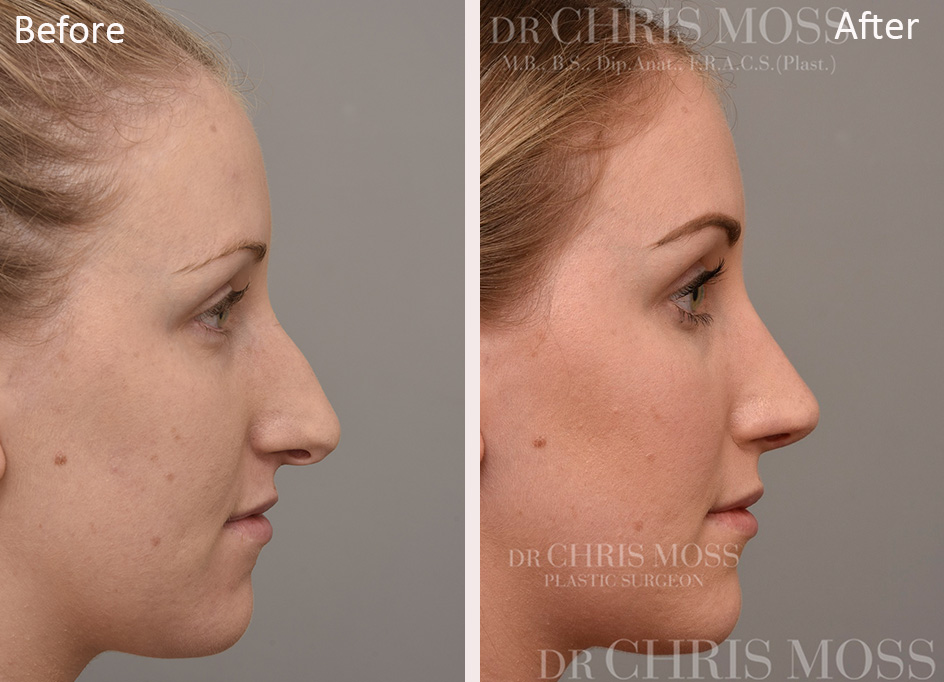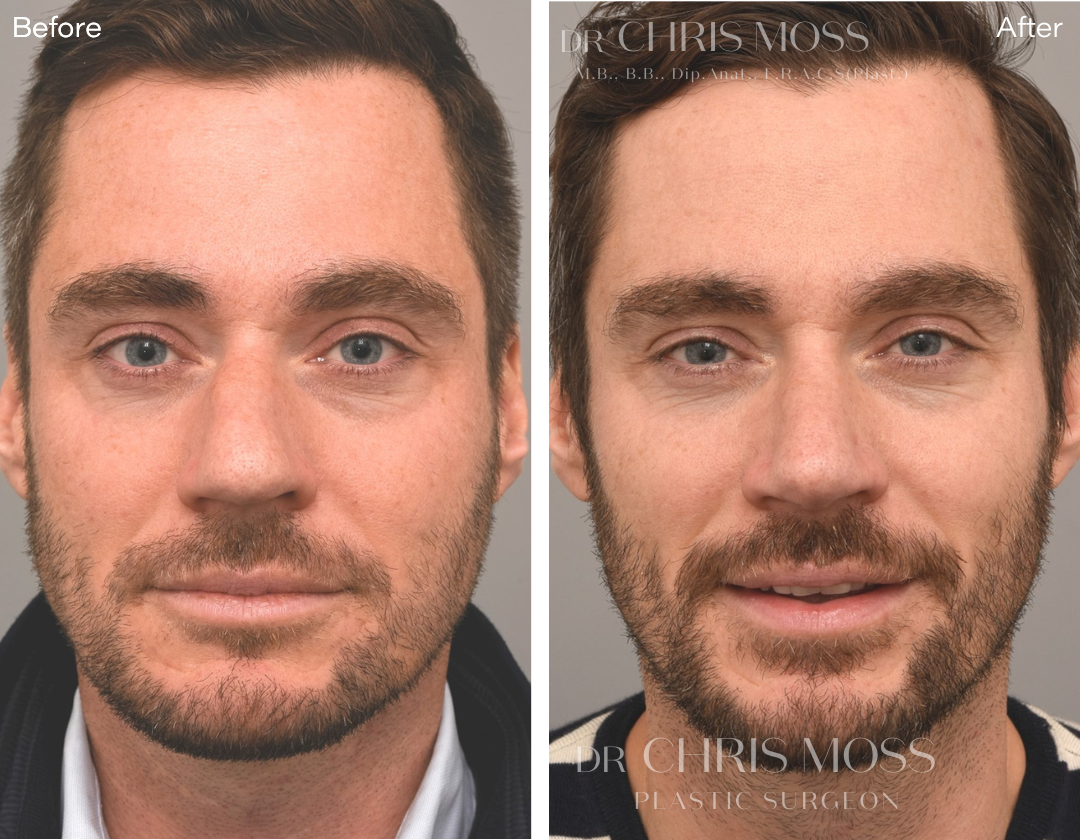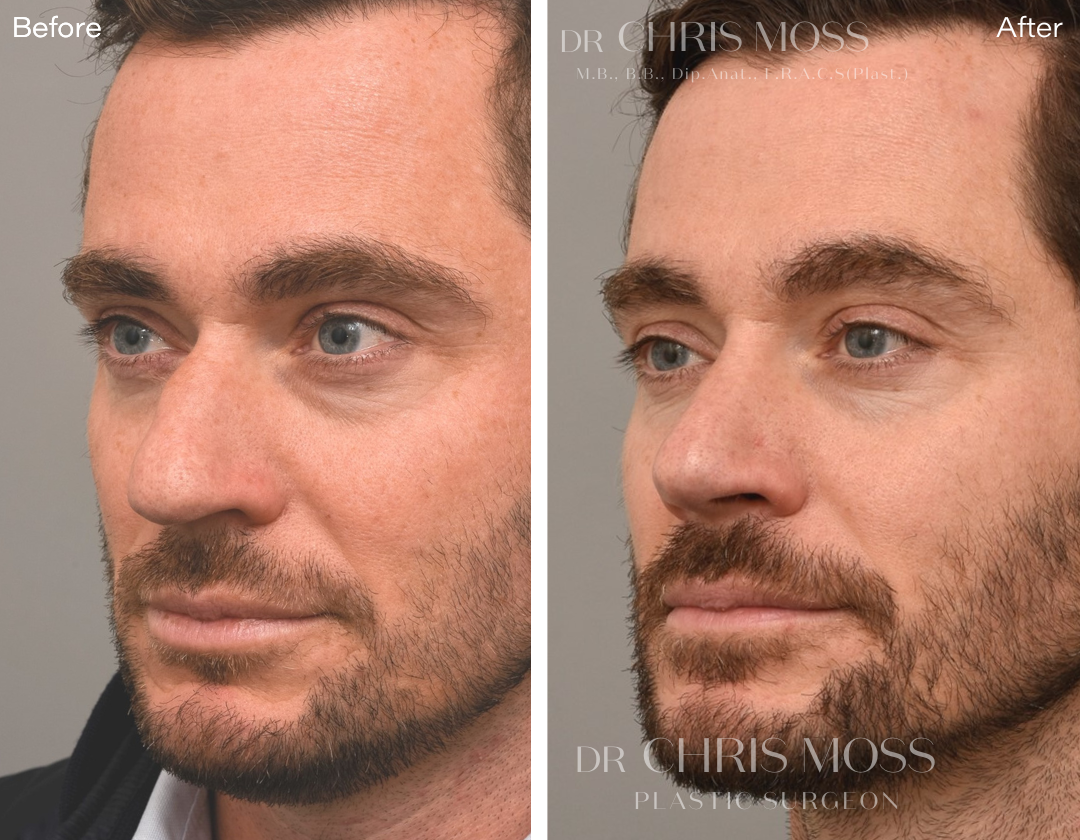Nose Surgery (Rhinoplasty)
Quality nose surgery requires skills in aesthetic judgement as well as surgical technique. Nose reshaping surgery is one of the most intricate procedures performed by plastic surgeons and takes decades of determined focus to master.
Rhinoplasty Surgery in Melbourne
As the most central feature on our face, the nose has a significant effect on our overall appearance. Decisions in regards to changing the shape of the nose must always be handled with great care and the surgery requires technical skill and experience. Since it requires careful attention to the tiniest of details, this precise and sophisticated surgery takes time. The best rhinoplasty results look like a natural nose and do not have to be redone to achieve this – so it is important to do what you can to get it right the first time!
Dr Moss performs nose reshaping surgery to improve the appearance of the nose, improve breathing and to correct structural damage caused by injury or inherited deformity.
Combining his aesthetic judgement with modern nose surgery techniques, Dr Moss aims to deliver an optimal result in all patients. Whether their concerns are cosmetic, functional or both, each person’s face is unique and so are their individual aims from surgery. Every patient must undergo detailed assessment including their concerns, aims and anatomy to design a surgical plan that is considered optimal for them. Dr Moss understands that the aim is patient satisfaction. To best work towards this it is vital that, after thorough assessment, both surgeon and patient must work together to decide on the surgical plan designed to deliver a result keeping with each patient’s realistic aims.
The expected range of result, limiting factors in their case and risks of surgery will be fully explained by Dr Moss. It is vital that you are fully informed, completely involved with the decision-making process, clearly understand the results possible from surgery with him, and are comfortable with the outcomes planned. Vectra 3D Computer Imaging generates a simulated image showing the way your nose could be expected to look after you make certain desired changes to its size, shape, balance and proportions.
Disclaimer: Results vary from person to person. These images are indicative only and reflect the results for this patient. All surgery involves risks & recovery period – see below.
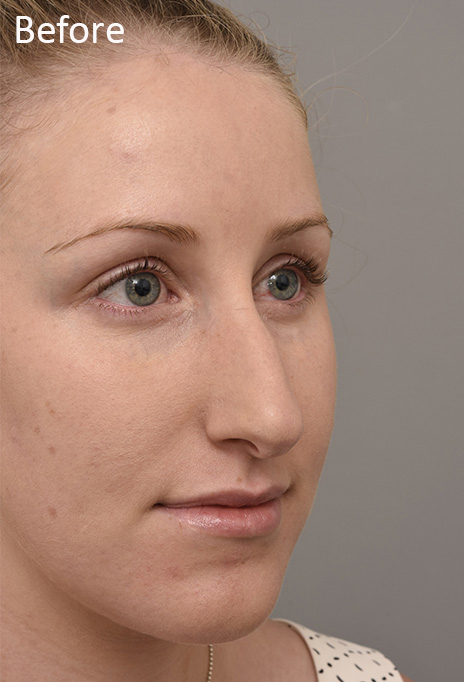
BEFORE
Areas of Concern for Treatment
- Shape of bridge & tip of nose
- Nose breathing concerns
Aim: Correction of drooping, boxy tip & straightening of bump on bridge.
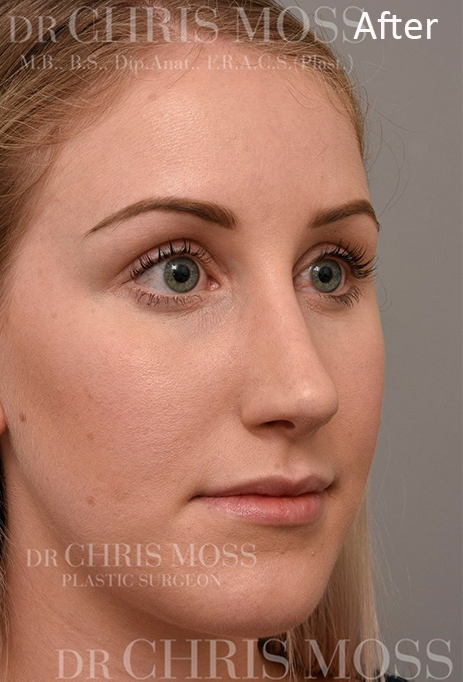
AFTER
- Open Septorhinoplasty
- Nasal airway surgery
The surgical result shown in the ‘After’ image addressed the listed Areas of Concern for Treatment.
Rhinoplasty Surgery with Dr Moss
Dr Moss has extensive experience in nose reshaping procedures and in performing complex redo (revisional) rhinoplasty surgery.
Dr Moss was the first Australian member of The Rhinoplasty Society, which is an international society comprising many of the most respected nasal surgeons in the field. Membership is by invitation only and requires a comprehensive screening process. Members are committed to innovation in their field of aesthetic and reconstructive nose surgery.
Dr Moss is also a Member of the Australian and American Societies of Plastic Surgeons and the Australian, American and International Societies of Aesthetic Plastic Surgery.
Nose Reshaping Surgery
Nose reshaping surgery is one of the most intricate procedures performed by plastic surgeons and takes decades of determined focus to master. Dr Moss uses structural and preservation rhinoplasty techniques designed to address patient concerns while supporting and preserving nasal integrity. Changes that are commonly requested include alteration or refinement in the shape, size, rotation and projection of the tip, removal of a dorsal bump, straightening of a deviated nose and reduction in nostril size. The aim of most rhinoplasty surgery is to bring the nose into better aesthetic balance or proportion with the rest of the face. For optimal and natural looking nasal surgery results the operated or surgical look must be avoided. While reduction in bulk or dimensions are performed commonly, open structural rhinoplasty techniques used by Dr Moss often include the use of small cartilage grafts, taken from within the nose, which are used to support and recontour areas of concern within the nasal framework. This helps provide more stable and predictable results over the long term. For improved surgical exposure and access, this surgery is usually performed as an open procedure via a fine incision made across the columella (which is the area at the underside of the nose between the nostrils). The incision is closed meticulously with fine absorbing sutures and the short surgical scar is usually barely visible because this area is under the nose and routinely heals so well.
Airway Surgery
Poor breathing due to airway obstruction is a relatively common problem that may be inherited, the result of trauma or injury, or due to collapse of the nasal passages inside the nostrils or nose (called the internal and external nasal valves). Functional rhinoplasty works to help improve or correct nose breathing problems and often includes correction of a deviated septum. Airway obstruction can also be caused by enlargement of the turbinates inside the nose. Dr Moss frequently performs surgery to improve the airway, either alone or at the same time as rhinoplasty surgery for cosmetic nose re-shaping. Surgical options he offers include external septorhinoplasty, endo-nasal (closed) septorhinoplasty, septoplasty, sub-mucous resection (SMR) of obstructions in the nasal septum, and partial inferior turbinectomy. Improving the nasal airway via functional rhinoplasty and airway surgery can enable patients to breathe better through their nose and this can provide other benefits such as increased exercise tolerance and endurance. Many also report other benefits such as increased ease of breathing when asleep, as well as a heightened sense of smell and even taste.
Vectra 3D Computer Imaging for Rhinoplasty
Disclaimer: Results vary from person to person. These images are indicative only and reflect the results for this patient. All surgery involves risks & recovery period – see below.
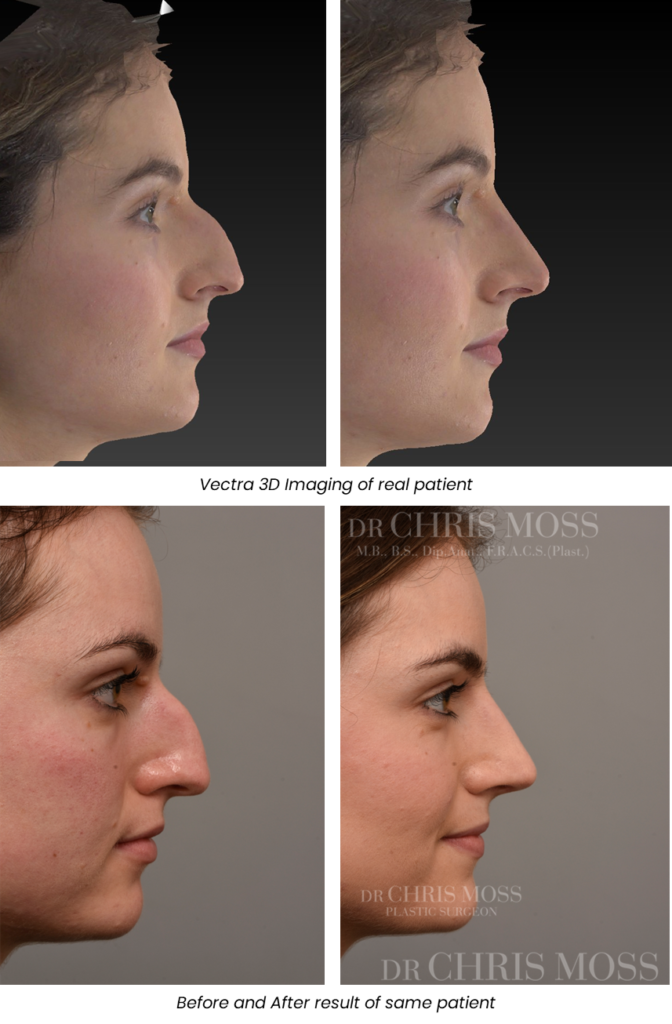
BEFORE
Areas of Concern for Treatment
- Shape of bridge & tip of nose.
- Nasal breathing concerns.
Aim: Reduce prominent bump on bridge with natural look & improve breathing.
AFTER
- Open Septorhinoplasty
The surgical result shown in the ‘After’ image addressed the listed Areas of concern for Treatment.
Our VECTRA 3D computer imaging technology uses a number of cameras to take multiple simultaneous pictures of your nose from several different points of view. This is used to build a three dimensional virtual model of your nose. This 3D image can be rotated on the screen and viewed by you from almost any angle. Your three dimensional image can then be processed by advanced Sculptor 3D software to display an image of a simulated appearance including desired changes to the size, and shape of your nose.
Our patients have reported that being able to see an image of the changes they are considering has greatly increased their ability to make decisions on what rhinoplasty options they prefer and are comfortable with.
Having an image of themselves (rather than just words) helps our patients communicate their aims.
Once you are confident that you have found the result you will be most satisfied with, then this image can be used by Dr Chris Moss to help develop a surgical plan that you are comfortable with. It is important to note that the Vectra 3D produces a simulated image only and it is not a promise of any exact result or outcome of surgery. Actual results can and do vary as they depend on factors that vary between individuals such as your anatomy and tissues, what is actually found and possible at surgery, and the quality of your healing.
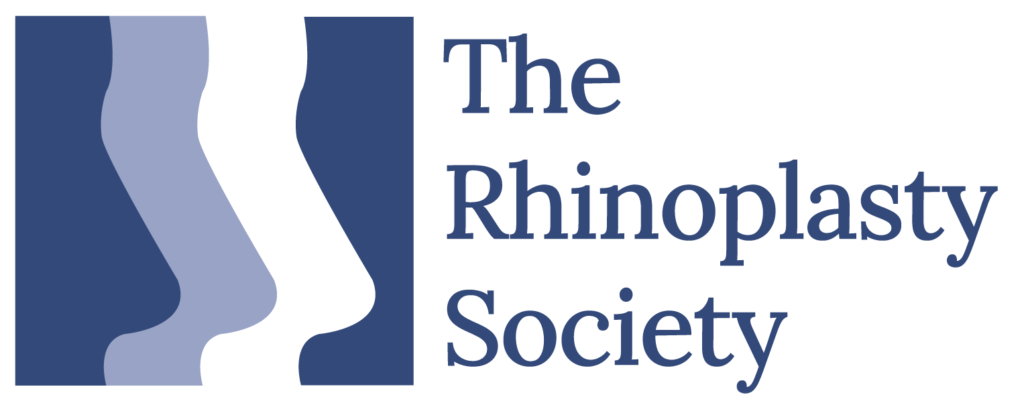
By invitation, Dr Moss was the first Australian member of The Rhinoplasty Society – an international membership of leading nasal surgeons.
Nose Surgery Results
Disclaimer: Results vary from person to person. These images are indicative only and reflect the results for each patient. All surgery involves risks & a recovery period – see below.
Further details and Recovery
Patients undergoing Rhinoplasty surgery may go home the same day or may stay a night in hospital, depending on the extent of surgery. Surgery is performed under General Anaesthetic. Small plastic nose splints are usually worn for one week and removed after 7 days when sutures are also removed. Dr Moss does not use nasal packs. You will have some temporary bruising and most of the swelling resolves in the first week, but may take months to settle. You can usually return to work and social life 10-14 days after surgery. You can resume light exercise by 2 weeks but refrain from more strenuous activity for 6 weeks.
Risks
All surgery has risks – no matter who performs the surgery. When surgery is performed by a trained and experienced plastic surgeon there will be measures and precautions put in place to help lower the risk of complications occurring. If complications do occur and require further treatment or revisional surgery, then a qualified surgeon is trained to manage such complications. During the consultation, Dr Moss will carefully explain the possible risks of your surgery so that you can make an informed decision.
Different patients will heal differently, and have different pain thresholds and will therefore experience different recovery times for different activities The following possible complications – which apply to all surgeons worldwide – are listed to inform you, rather than to alarm you. A number of these risks are rare and have not occurred to date in Dr Moss’ practice. Further details on the level of any risk in your particular circumstances, including the possible impact of any comorbidities you may have, are provided in your consultation.
All patients are likely to experience some temporary discomfort/pain, numbness or altered sensation around the incisions or operated areas; bruising and swelling; skin discolouration; lumpiness, tightness, fatigue, low spirits; and nausea – typically from the anaesthetics or pain killers, which may require treatment.
General risks of surgery include wound infection, haematoma (collection of blood under the skin), abnormal scarring or internal scar tissue, bleeding from the incisions, allergies or reactions to anaesthetic agents, medications, sutures or topical treatments, delayed healing or separation of wound edges.
Specific Risks of Rhinoplasty Surgery include prolonged visible swelling that may last for weeks & sometimes months, loss of structural support may cause collapse of the nasal airways during breathing; perforation of the nasal septum; nasal breathing may possibly change; rarely a reduced sense of smell; reddening of the nasal skin (capillaries); bending or movement of a cartilage graft away from its ideal position; deviation of the nose or septum; some patients may need a further procedure to further improve the outcome.
Risks of Anaesthesia include tooth damage; heart attack; pneumonia; blood clot in the leg or lung, and stroke. These are uncommon but could be life threatening.
Commonly Asked Questions
When structural support is deficient in a nose or when desired reduction of prominent cartilage or bone can weaken the structure of a nose, then the surgeon must provide the required architectural framework support for the nose as part of the rhinoplasty. Open structural rhinoplasty involves an open approach to the surgery, harvesting small cartilage grafts from the back of the nose septum, and placing these grafts as supports for nose cartilages that are collapsed or require reshaping or augmentation to achieve the desired result. As well as supporting nasal aesthetics these provide better stability of results over the long term. This takes a little extra time and expertise, but is worth the investment.
Dr Moss’ philosophy is to prioritise a customised and natural looking result for each patient. Results should be in proportion with each patient’s individual face. The surgeon must not take short cuts or use a “cookie cutter” approach to aesthetic judgement. Priority must be placed on avoiding the operated look so the result does not look detectably like the result of surgery.
Dr Moss considers it false economy to shop around based primarily on just the lowest price or the quickest operation as your result depends on the surgery performed – particularly in rhinoplasty surgery. It is important to find a qualified plastic surgeon who has a high rate of achieving pleasing outcomes and has extensive experience performing both primary and revision rhinoplasty.
Traditional rhinoplasty techniques tended to focus on more radical excision of cartilage and bone to produce appearance change or size reduction. In modern rhinoplasty this avoided because, although these traditional techniques are quicker and technically easier to perform than structural rhinoplasty techniques, they are associated with a far greater chance of long term collapse, airway issues and an operated look.
The aim in cosmetic rhinoplasty should be to address each patient’s individual concerns while creating a nose that is proportionate, natural looking and in balance with the rest of the face. Often surgery involves only subtle changes at surgery so the amount of surgery can be lessened. Dr Moss prioritises the avoidance of the “operated look”.
Approximately 25% of Dr Moss’ rhinoplasty patients are male.
That is a decision you will make with your referring medical practitioner and Dr Moss.
The decision to undergo rhinoplasty is a personal matter and is a decision that patients have to make for themselves. Good candidates for nose surgery are realistic and self-motivated. They want to improve their appearance for their own satisfaction – not for others! Successful rhinoplasty surgery can deliver improvements in keeping with a patient’s individual requests, whether subtle or more significant. The ideal final result should look refined and balanced yet natural, and undetectable as the result of surgery.
Achieving the best possible long term cosmetic and functional results should be your highest priority.
Achieving the best possible long term cosmetic and functional results should be your highest priority. As a perfectionist in rhinoplasty, Dr Moss aims for every nose to look the best it can, breathe well and be in balance with the rest of the face.
There is no single best age for rhinoplasty. Rhinoplasty should be delayed until nasal development is completed and is usually performed from the twenties onwards.
Rhinoplasty is one of the most difficult operations in plastic surgery. Rhinoplasty techniques involve reshaping the existing nose, via either an open or closed approach.
Open rhinoplasty surgery involves a small incision at the base of the nose to lift the skin. Closed rhinoplasty involves incisions within the nostrils. Dr Moss usually prefers to use the technique of open rhinoplasty to provide superior exposure and access to address aesthetic and structural concerns in the nose.
Dr Moss uses open structural rhinoplasty and preservation rhinoplasty techniques which emphasise the re-supporting and preservation of nasal structure and strength. Modern rhinoplasty techniques have significantly improved the quality, predictability and long term stability results and, while perfection is not a realistic expectation, satisfaction rates are high in our experience.
With our Vectra 3D computer imaging technology you will be able to see a simulated image of how your desired changes look on your face. Dr Moss will explain what range of result is and isn’t possible from modern surgery in his hands.
Although there is a degree of bruising it is usually not socially visible after 10-14 days by which time most patients are able to return to work. Pain is usually well controlled with simple analgesics. Dr Moss does not use nasal packs but small plastic nose splints are worn for one week. Patients may gradually return to exercising starting two weeks after surgery. Contact sports must be avoided for six weeks.
Dr Moss uses techniques at surgery to help reduce the likelihood of complications and optimise benefits. All surgery, even in experienced hands, has limitations and risks. Although complications can and do happen, the likelihood of needing re-operation is not high. Thick skin is the most common limitation seen and can impair the amount of nose reduction or definition that can be achieved because it can be difficult for thick skin to shrink and conform to the reduced underlying nasal framework. Surgeons can only do so much with reshaping a nose if the skin will not contract. Dr Moss is experienced in surgery on the ethnic or thick skinned nose.
Dr Moss regularly performs corrective nose surgery on patients who have had nose operations performed elsewhere with a less than desired result.
